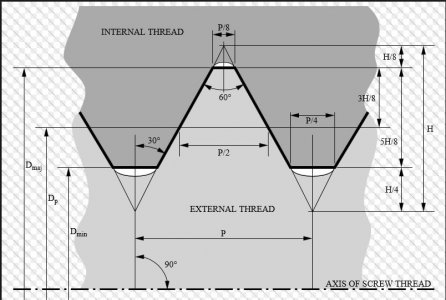- Joined
- Jun 22, 2023
- Messages
- 728
what is the best threading mill to use in a CNC router? i plan on working in aluminum

good info and after i have re-read this a few times and digested it a few more times i will have questions. my immediate project goal is to build an aluminum mini pallet to use on my cnc router and my mini mill. i'm thinking a 1/4-20 60deg single tooth mill would be a good place to start?A thread mill really has several dimensions that are of consequence. The major diameter of the cutter will determine the smallest sized internal thread which can be cut while the difference between the major diameter and the diameter of the reduced shank will determine the coarsest pitch that can be cut. In the diagram below, you can see the relationship between the thread pitch and the depth of thread for external and internal threads. The value for h is p*sin60º or .866*p. For an external thread, the ideal thread is truncated by 1/8*p. My thread-mills have essentially a zero radius at the tip of the cutter so the maximum depth which it can cut is 7/8*h. This amounts to .758*p. The difference between the major diameter and the reduce shank diameter is twice this value.
View attachment 456053
As an example, my "1/2-13 or smaller" thread mill has a major diameter of .371" and reduced shank diameter of .227" for a difference of ,144". Half that is .072" which equals .758*p. This equals a thread pitch of .095" or 10.52 tpi. In theory, I can cut 11 tpi threads and finer. For my "1/4 -20 or smaller" thread mill . the ,major diameter is .181" and the reduced shank diameter is .099" for a difference pf .082". The calculated maximum pitch is 18.5 tpi..
For internal threads, the major diameter of the thread mill has to be able to fit inside the tap drill hole. For 75% threads, the tap drill hole is equal to the nominal thread diameter less the pitch or d-p. Using my "1/2 -13" or smaller thread mill, I couldn't cut a 7/16-14 internal thread with 75% thread as the tap drill size would be .367 which is smaller by .004". I could go for 60% thread engagement though. By the same token the smallest internal thread my "1/4 - 20 or smaller" thread mill will cut is a #12 and that only with a 75% thread engagement.
Finally, the length of the reduced shank determines the length of thread which can be cut. which is relatively short; .400" and .550" for my two thread mills.
Thread mills excel in being to cut internal threads to literally one thread from the bottom of a hole. They also can produce multiple threads which are clocked exactly the same. But they have limitations. Because of those limitations and the relatively high cost, I reserve them for times when there is no other way to achieve my design goals.
That sounds like a good use. Power tapping on z CNC router would probably be pushing it too hard and manual tapping a large number of holes will be achore. . It will be an easy task for a thread mill.good info and after i have re-read this a few times and digested it a few more times i will have questions. my immediate project goal is to build an aluminum mini pallet to use on my cnc router and my mini mill. i'm thinking a 1/4-20 60deg single tooth mill would be a good place to start?
thanks for the info it helps a lot.
